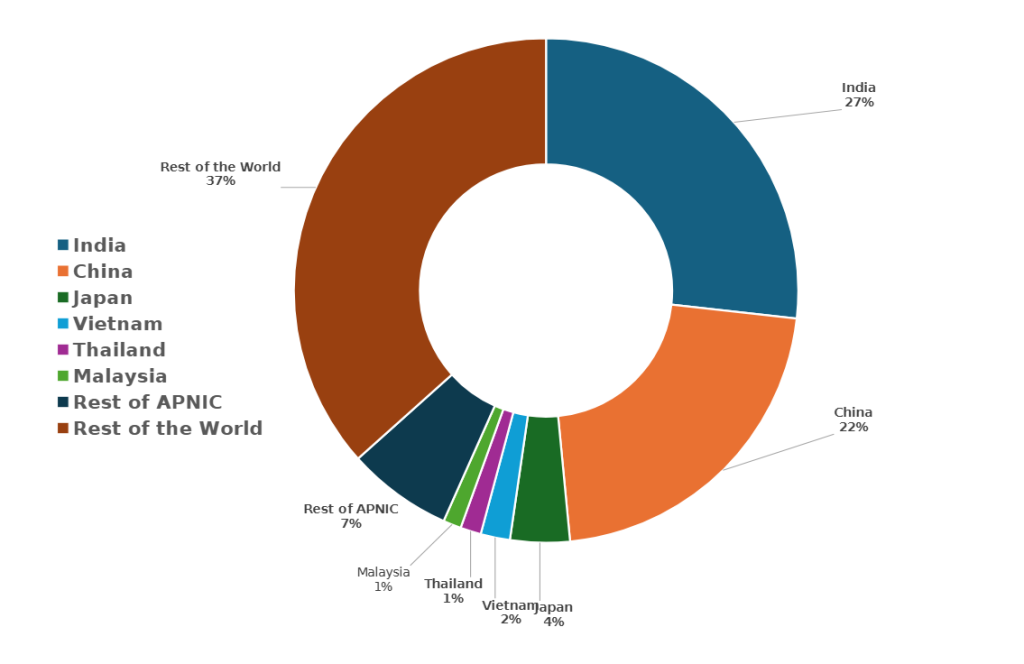
We’re delighted to announce that APNIC Labs has now recorded a consistent 30-day average of IPv6 capability exceeding 50% across all 56 APNIC economies. This marks a significant milestone, achieved 25 years after the regional journey with IPv6 first began.
Figure 1 — Current IPv6 capability comparing the world and the APNIC region.
How is this measured?
APNIC Labs collects around 25 million daily tests from end users worldwide using matched DNS name sets with IPv4-only, IPv6-only, or dual-stack addresses. Each sample is tagged by its economy and origin-AS, then weighted using World Bank Internet user data to enable consistent aggregation across all 56 APNIC region economies. The results are averaged over the past 30 days and used as the standard reporting method for APNIC EC quarterly reports.

Explaining capable vs preferred
When measuring IPv6 usage, if APNIC Labs can fetch a URL using IPv6, then the host system is labelled ‘IPv6 capable’. However, if it uses IPv6 to fetch the dual-stack URL, it’s labelled ‘IPv6 preferred’. More details are available at APNIC Labs.
Global IPv6 deployment
As Figure 3 shows, significantly more than half of the world’s IPv6 comes from the Asia Pacific economies.

Globally, APNIC economies account for 64% of global IPv6 users and have an aggregate IPv6 capability of 50%, significantly influencing the global average, which stands at around 40%. ARIN economies, while representing 9.4% of the world’s IPv6 users, lead in capability with 52%. LACNIC and RIPE NCC regions show moderate adoption, with capabilities of 39% and 28% respectively, and user shares of 10.7% and 16%. AFRINIC remains behind, with 0.94% of global IPv6 users and a capability of 4%.
| Region | % of global IPv6 users | Aggregate IPv6 capability |
| AFRINIC | 0.9% | 4% |
| APNIC | 64% | 50% |
| ARIN | 9.4% | 52% |
| LACNIC | 10.7% | 39% |
| RIPE | 16% | 28% |
The ranking of individual economies in IPv6 deployment reflects a combination of population size, policy support, and infrastructure investment. In the APNIC region, economies like China and India lead in IPv6 deployment due to their vast number of active Internet users, strong national policies promoting IPv6, and recent significant capital investments. Other economies with large populations, such as Viet Nam, Thailand, South Korea, and Japan, also show substantial IPv6 deployment levels (Table 2).
| CC | Economy | IPv6 capability % | Users |
| CN | China | 45.28% | 810,519,875 |
| IN | India | 78.16% | 600,671,221 |
| ID | Indonesia | 14.93% | 115,444,083 |
| JP | Japan | 58.2% | 109,438,612 |
| PH | Philippines | 17.66% | 79,160,582 |
| VN | Viet Nam | 60.18% | 54,269,706 |
| KR | Republic of Korea | 23.75% | 51,142,259 |
| TH | Thailand | 50.62% | 45,014,196 |
| PK | Pakistan | 20.59% | 40,485,679 |
What does this mean for the future?
The global Internet is expected to remain dual-stack for the foreseeable future, as the transition to IPv6 is progressing at a linear rate, currently at 34%. However, capital investment is driving change, and with the rollout of 5G and 6G systems in more economies, IPv6 capability growth in the mobile sector is likely to remain strong worldwide.
Broadband systems often have longer capital investment cycles, which can slow IPv6 adoption in cases where pre-IPv6-capable technology is still in use, as seen in South Korea and parts of South America. However, economies like the UK demonstrate that field-upgradable Customer-Premises Equipment (CPE) can enable rapid IPv6 deployment. Similarly, national upgrade plans in economies like China and Viet Nam have accelerated IPv6 adoption in the broadband sector.
Got your IPv6 yet?
We encourage more operators to start or speed up their deployments — IPv6 is essential for the Internet’s growth and stability.
APNIC Members who have an IPv4 delegation are automatically eligible for IPv6. Requesting it is quick and easy: Just log in to MyAPNIC and click ‘IPv6 One Click’. No forms, no fee increase.
Learn more: Go IPv6.
The views expressed by the authors of this blog are their own and do not necessarily reflect the views of APNIC. Please note a Code of Conduct applies to this blog.
